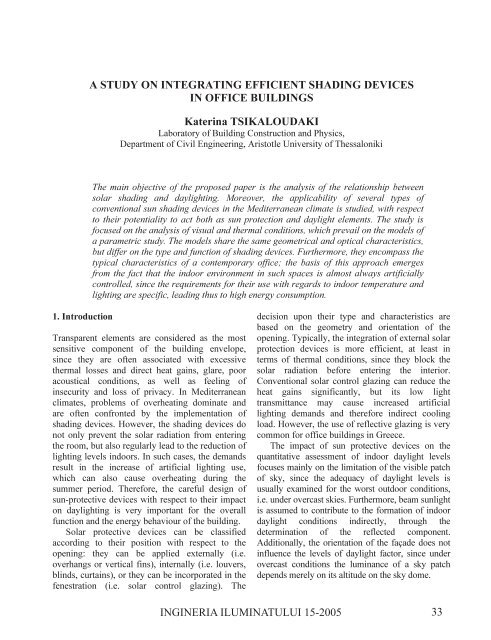Ingineria Iluminatului - Journal of Lighting Engineering - Prof. Florin ...
Ingineria Iluminatului - Journal of Lighting Engineering - Prof. Florin ...
Ingineria Iluminatului - Journal of Lighting Engineering - Prof. Florin ...
You also want an ePaper? Increase the reach of your titles
YUMPU automatically turns print PDFs into web optimized ePapers that Google loves.
1. Introduction<br />
A STUDY ON INTEGRATING EFFICIENT SHADING DEVICES<br />
IN OFFICE BUILDINGS<br />
Katerina TSIKALOUDAKI<br />
Laboratory <strong>of</strong> Building Construction and Physics,<br />
Department <strong>of</strong> Civil <strong>Engineering</strong>, Aristotle University <strong>of</strong> Thessaloniki<br />
The main objective <strong>of</strong> the proposed paper is the analysis <strong>of</strong> the relationship between<br />
solar shading and daylighting. Moreover, the applicability <strong>of</strong> several types <strong>of</strong><br />
conventional sun shading devices in the Mediterranean climate is studied, with respect<br />
to their potentiality to act both as sun protection and daylight elements. The study is<br />
focused on the analysis <strong>of</strong> visual and thermal conditions, which prevail on the models <strong>of</strong><br />
a parametric study. The models share the same geometrical and optical characteristics,<br />
but differ on the type and function <strong>of</strong> shading devices. Furthermore, they encompass the<br />
typical characteristics <strong>of</strong> a contemporary <strong>of</strong>fice; the basis <strong>of</strong> this approach emerges<br />
from the fact that the indoor environment in such spaces is almost always artificially<br />
controlled, since the requirements for their use with regards to indoor temperature and<br />
lighting are specific, leading thus to high energy consumption.<br />
Transparent elements are considered as the most<br />
sensitive component <strong>of</strong> the building envelope,<br />
since they are <strong>of</strong>ten associated with excessive<br />
thermal losses and direct heat gains, glare, poor<br />
acoustical conditions, as well as feeling <strong>of</strong><br />
insecurity and loss <strong>of</strong> privacy. In Mediterranean<br />
climates, problems <strong>of</strong> overheating dominate and<br />
are <strong>of</strong>ten confronted by the implementation <strong>of</strong><br />
shading devices. However, the shading devices do<br />
not only prevent the solar radiation from entering<br />
the room, but also regularly lead to the reduction <strong>of</strong><br />
lighting levels indoors. In such cases, the demands<br />
result in the increase <strong>of</strong> artificial lighting use,<br />
which can also cause overheating during the<br />
summer period. Therefore, the careful design <strong>of</strong><br />
sun-protective devices with respect to their impact<br />
on daylighting is very important for the overall<br />
function and the energy behaviour <strong>of</strong> the building.<br />
Solar protective devices can be classified<br />
according to their position with respect to the<br />
opening: they can be applied externally (i.e.<br />
overhangs or vertical fins), internally (i.e. louvers,<br />
blinds, curtains), or they can be incorporated in the<br />
fenestration (i.e. solar control glazing). The<br />
decision upon their type and characteristics are<br />
based on the geometry and orientation <strong>of</strong> the<br />
opening. Typically, the integration <strong>of</strong> external solar<br />
protection devices is more efficient, at least in<br />
terms <strong>of</strong> thermal conditions, since they block the<br />
solar radiation before entering the interior.<br />
Conventional solar control glazing can reduce the<br />
heat gains significantly, but its low light<br />
transmittance may cause increased artificial<br />
lighting demands and therefore indirect cooling<br />
load. However, the use <strong>of</strong> reflective glazing is very<br />
common for <strong>of</strong>fice buildings in Greece.<br />
The impact <strong>of</strong> sun protective devices on the<br />
quantitative assessment <strong>of</strong> indoor daylight levels<br />
focuses mainly on the limitation <strong>of</strong> the visible patch<br />
<strong>of</strong> sky, since the adequacy <strong>of</strong> daylight levels is<br />
usually examined for the worst outdoor conditions,<br />
i.e. under overcast skies. Furthermore, beam sunlight<br />
is assumed to contribute to the formation <strong>of</strong> indoor<br />
daylight conditions indirectly, through the<br />
determination <strong>of</strong> the reflected component.<br />
Additionally, the orientation <strong>of</strong> the façade does not<br />
influence the levels <strong>of</strong> daylight factor, since under<br />
overcast conditions the luminance <strong>of</strong> a sky patch<br />
depends merely on its altitude on the sky dome.<br />
INGINERIA ILUMINATULUI 15-2005 33 1
















